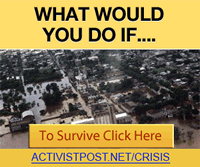 Janet Phelan
Janet Phelan
Activist Post
A study published in The Royal Society Interface by researchers at MIT may influence policy as to potential travel restrictions in an epidemic.
The study suggests that such restrictions will slow the progress of a pandemic. What is implicit in the paper’s recommendations is that people may be confined—quarantined in fact—to a heavily affected area, thus reducing their individual chances to survive but also mitigating the spread of the contagion.
As reported in Bioprepwatch, the study “compared contagion rates in two scenarios, one with travel restrictions and one without the restrictions. Previous research showed that individuals who become aware of an epidemic travel by taking the shortest route to avoid infected areas, even if they are already infected. The behavior, known as selfish behavior in game theory, exposes people in uninfected areas to disease.” Using computer modeling, the study tracked a hypothetical infectious disease as it advanced through commuting networks in the contiguous U.S.A.
The study failed, however, to account for or mention the fact that the U.S. has been mined—booby trapped—with bio/chem warfare delivery systems.
Since the early seventies, when President Richard Nixon unilaterally declared the termination of the biological warfare program in the United States, the U.S. government has been stealthily constructing not one but several domestic delivery systems for a biological or chemical weapons deployment. (Source). Briefly, the concerns revolve around the reconfiguration of water systems, vaccines and imposter pharmaceuticals. The best cover for such a deployment would be, of course, an epidemic.
The U.S. signed the Biological Weapons Convention in 1972. Since that time, the U.S. has heavily influenced the course of this international treaty. Unlike other weapons treaties, the BWC has no teeth. It has no verification protocol and no means to implement its ban.
In 2001, a long awaited verification mechanism had been hammered out by a working group but the U.S. emphatically refused to endorse it, thereby ensuring that the BWC remained a paper tiger. Six months later, the anthrax attacks were launched against selected members of Congress and also several media outlets.
As a result of the attacks of September 11 and the subsequent anthrax mailings, the Congress rushed to pass the USA PATRIOT Act. Embedded in this Act, which has altered the entire Constitutional framework governing the rights of the populace as related to government actions and intrusions, is Section 817—the Expansion of the Biological Weapons Statute. Within this Section, which has been scantily reported in the press, the U.S. government gives itself and its agents immunity from the prohibitions contained in the Biological Weapons Statute and effectively signed off from the prohibitions in the BWC.
 Since the attacks of September 2001, the United States has pumped over 70 billion dollars into what is euphemistically called “biodefense.” As every college level science student knows, biodefense is a blade which cuts two ways. In order to “defend” against an agent, as in creating a countermeasure, one first must have the disease itself at hand. The now defunct Sunshine Project repeatedly pointed out that there was no public oversight provided as to what was going on in these 70 billion dollar projects.
Since the attacks of September 2001, the United States has pumped over 70 billion dollars into what is euphemistically called “biodefense.” As every college level science student knows, biodefense is a blade which cuts two ways. In order to “defend” against an agent, as in creating a countermeasure, one first must have the disease itself at hand. The now defunct Sunshine Project repeatedly pointed out that there was no public oversight provided as to what was going on in these 70 billion dollar projects.
Recently, both China and Russia have accused the U.S. of biological weapons violations in or near their countries.
Bioprepwatch reports the primary author of the study, Christos Nicolaides, as stating: “Although the study is an idealized scenario, it does give insight to authorities about when and where it would be important to impose route restrictions on human mobility in the case of an emergent outbreak or in the extreme case of bioterrorism.”
In the case of a bona fide pandemic, quarantine or travel restrictions may serve to contain a contagion. In the case of a U.S. sponsored domestic bioterror attack, such travel restrictions would only ensure more death.
Janet Phelan is an investigative journalist whose articles have appeared in the Los Angeles Times, The San Bernardino County Sentinel, The Santa Monica Daily Press, The Long Beach Press Telegram, Oui Magazine and other regional and national publications. Janet specializes in issues pertaining to legal corruption and addresses the heated subject of adult conservatorship, revealing shocking information about the relationships between courts and shady financial consultants. She also covers issues relating to international bioweapons treaties. Her poetry has been published in Gambit, Libera, Applezaba Review, Nausea One and other magazines. Her first book, The Hitler Poems, was published in 2005. She currently resides abroad. You may browse through her articles (and poetry) at janetphelan.com
linkwithin_text=’Related Articles:’


Be the first to comment on "Trapped in a Killing Field: MIT study suggests travel restrictions in the event of an epidemic"